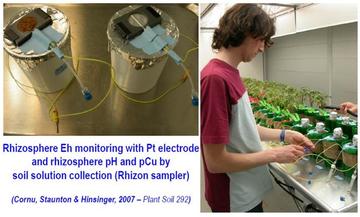Redox changes in the rhizosphere
In well aerated soils displaying oxidant conditions, so called “strategy I” plant roots are able to lower the oxido-reduction potential of the rhizosphere in order to increase the phytoavailability of iron. However, these changes can have repercussions for the phytoavailability of trace elements. For instance, some measurements of oxido-reduction potential have been obtained by the RHIZOtest with a view to studying the phytoavailability of copper for tomatoes grown in soils with a previous grapevine crop [1].
Conversely, in flooded soils displaying highly reducing conditions, plant roots are able to increase the oxido-reduction potential by releasing atmospheric oxygen into their rhizosphere. A study conducted with a modified RHIZOtest system revealed that this oxidation ability made it possible to limit the phytoavailability of arsenic for rice [2].
1. Cornu JY, Staunton S et Hinsinger P 2007 Copper concentration in plants and in the rhizosphere as influenced by the iron status of tomato (Lycopersicon esculentum L.). Plant Soil, 292, 63-77.
2. Bravin MN, Travassac F, Le Floch M, Hinsinger P and Garnier JM 2008 Oxygen input controls the spatial and temporal dynamics of arsenic at the surface of a flooded paddy soil and in the rhizosphere of lowland rice (Oryza sativa L.) : a microcosm study. Plant Soil, 312, 207-218.

